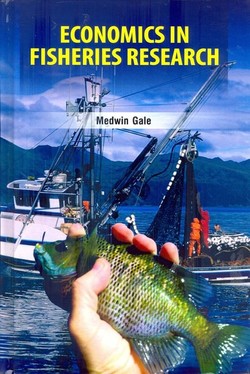
Economics in Fisheries Research
By
Medwin Gale
Preface
Fisheries Research has been evolved over centuries. Its initial focus was on the identification of different species and their arrangement into systematic taxonomies. Later emphasis was on the ecology of the target species, their biomass and distribution, their behaviour, and the environment in which they lived
"Economics of fisheries" is a field of economic research that has developed since the mid-1950s. The core of the research in its early stage was to find conditions for optimal exploitation of fish stocks over time. The purpose is to inform policymakers about harvest levels that maximize net present value of the fish stock. At the same time, the fundamental insight was developed that in absence of effective regulation or collective control over harvest behavior the fish stocks tend to be overexploited from both a biological and economical point of view.
Fisheries science and modelling developed rapidly during a productive and innovative period, particularly among fisheries researchers of various disciplines. Population modelling and fishing mortality were introduced to economists, and new interdisciplinary modelling tools became available for the economists, which made it possible to evaluate biological and economic impacts of different fishing activities and fisheries management decisions.
Fisheries science is the academic discipline of managing and understanding fisheries. It is a multidisciplinary science, which draws on the disciplines of limnology, oceanography, freshwater biology, marine biology, conservation, ecology, population dynamics, economics and management to attempt to provide an integrated picture of fisheries. In some cases new disciplines have emerged, as in the case of bioeconomics and fisheries law.
The farming of aquatic organisms like fishes, aquatic plants, molluscus, crustaceans etc, is known as aqualculture. Aquaculture, also known as aquafarming, is the farming of aquatic organisms such as fish, crustaceans, molluscs and aquatic plants. Aquaculture involves cultivating freshwater and saltwater populations under controlled conditions, and can be contrasted with commercial fishing, which is the harvesting of wild fish.
The main focus of this book is the economic aspect of fisheries research. It is enriched with experiences in developing countries because this is where much of the innovative work in fisheries research is being carried out.
Contents
1 - Economic Value of Fishes
■ Useful fishes
■ Understanding the Economics of Fishing
■ Yield and Stock Effects of Fishing
■ Economic Definitions of Profit
■ Fisheries Today -Growth, Expansion and Trade
■ The Collapse of Many of the Worlds Fisheries
■ Growth of the Fisheries Sector in India
■ Marine Fisheries Scenario of Kerala
2 - Fisheries Research
■ Predation mortality
■ Advances of Fish Behaviour
■ Fisheries Statistics and Information
■ Background to the Origin and Elaboration of the Code
■ Assessing the Fisheries
■ Fisheries Research and Statistics
3 - Freshwater Fish
■ Fisheries in the Basin and Cold Water Upland Fisheries
■ Warm Water Lowland Fisheries
■ Majority of Freshwater Fish Ponds
■ Non- Fresh Water Fish Culture
■ On-Fish Aquaculture
■ Fish Species Suitability and Selection
■ Species Grow Successfully in Ponds
4 - Trade implications of fish species identification and Research
■ Important Species
■ Culture Technology for Seabass
■ Culture Techniques
■ Issue of Species Production
■ Subsidies, Sustainability and Trade
■ International Trade in Aquaculture Products
■ Food Utilisation and Value-adding
5 - Small-Scale Fisheries: On Rights, Trade and Subsidies
■ Aquaculture and its Economics
■ Generation of Employment and livelihood
■ Ecological Sustainability of Aquaculture over Capture Fisheries
■ Aquaculture and Fisheries in Asiatic Region
■ Aquaculture and Fisheries in India: The Current Scenario
■ Markets, Trade and Food Sovereignty
■ Trade, Subsidies and Rights
■ Honduras
6 - Fish Marketing Practices and Structure
■ Marketing Intermediaries and Channels
■ Fish-Marketing Channels
■ Market and Trade Routes
■Market Infrastructure and Physical Facilities
7 - Economic Efficiency in Fish Integration
■Management of Fish-Cum-Cow Integration
■ Layout of an Integrated Fish Farm
■The Advantages of Integrated Fish Farming
■ The Integrated Fish Farming Practices
■The Production of Integrated Fish Farming
■ Fish-Livestock-Crops Integration
8 - Transport and Marketing of Fisheries
■ Transport of Fresh Fish
■ Transport of Live Fish
■ Marketing
■ Transaction Systems
■ Description of Fish Marketing Channels
***for more please visit the library***
Prep. / Ayman Ashry
Manage. / Mona Mahmoud



ساحة النقاش